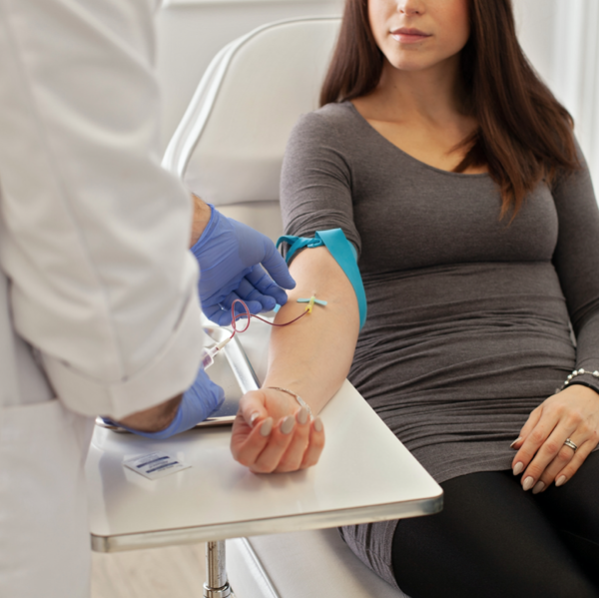- Fast results
- 4,000+ locations
- 4.8 star rating
Need Help? (888) GET LABS



This article is Medically Approved ✓ by Dr. Edward Salko
Sickle cell anemia is a genetic disorder characterized by the abnormal structure of the red blood cell (RBC). This condition is diagnosed among infants aging four months.
However, children and adults can also be tested. In some cases, a person can inherit the sickle cell gene without showing symptoms of the disease.
Instead, they become carriers and can potentially pass on the genetic condition to their children.
According to the CDC, an estimated 100,000 Americans are affected by sickle cell anemia.
However, the exact number of people that are living with the disorder is still unknown. Thereby, sickle cell anemia blood tests are required.
If you have a family history of this condition, consider getting tested and ensure that your children are screened for sickle cell anemia.
Learn more about this genetic disease and how testing is performed. Read on.
The red blood cell (RBC), which functions to carry oxygen to the cells and remove waste products from them, is the primary target of this genetic condition.
Normal RBC takes the form of a disc that allows flexibility in moving through small and narrow blood vessels.
A person diagnosed with sickle cell anemia or sickle cell disease (SCD) has RBCs shaped like a crescent or a sickle. This deformation hinders the free flow movement of RBCs in the bloodstream.
Instead, they are commonly rigid and sticky. This keeps them wedged in narrow blood vessels, creating a blockage and causing delays in delivering oxygen to cells and removing carbon dioxide.
The production of abnormal hemoglobin brings about the misshapen RBC. This faulty hemoglobin, also known as hemoglobin S (Hgb S), is due to the mutation in the HBB gene.
SCD is classified as an autosomal recessive disorder, which means that there should be two copies of the HBB gene for people to develop the condition. It can pan out in two scenarios. First, only one parent has the disease while the other is a carrier. Second, both parents are either carriers or SCD positive.
Most patients diagnosed with SCD had started to show symptoms by the time they were six months old. Hence, parents need to pay close attention to the following conditions, especially if the infant did not undergo prenatal screening.
A sickle cell crisis is characterized by pain in any part of the body, like the spine, chest, arms, or legs. It can range from mild to severe and can last from hours to days.
This painful episode is also called a pain crisis. It can be triggered by cold temperatures, low oxygen intake, dehydration, stress, and infections.
Doctors often prescribed pain relievers to treat a sickle cell crisis depending on the severity of the pain. Sometimes over-the-counter medications can soothe the pain, while in cases of prolonged and severe pain, IVF-infused pain relievers like morphine are needed.
Several complications may come with sickle cell anemia, especially if the correct treatment is not secured. These include the following:
This condition is characterized by swelling in the feet and hands. It is typically the first sign of the disorder among infants.
Neurological Problems
Brain blockages can occur for patients with SCD. In turn, it causes strokes and seizures. In severe cases, it could lead to coma.
The blood vessels in the eyes are tiny that sickle RBCs may be trapped. Hence, causing poor eyesight or complete vision loss.
Blockage can also occur in the spleen’s blood vessels, causing severe loss of function in the organs. Patients may have to undergo surgical removal of the spleen called a splenectomy.
Since RBCs are not in their standard shape, they often expired earlier, causing a shortage in RBC.

The standard newborn screening already includes an assessment for SCD. The HBB gene is also detected even before the baby is born through evaluating the amniotic sac.
If symptoms develop among infants and can be observed in children and adults, a blood test is often ordered.
A sickle cell anemia blood test is a qualitative identification of hemoglobin S. The blood test looks for sickling RBCs, evaluates hemolytic anemia, and detects undiagnosed hereditary anemia with sickle-like abnormalities on peripheral blood smear.
The blood test often employs Hb electrophoresis, in which the level of hemoglobin levels and abnormal types are assessed.
Suppose you have a family history of SCD. In that case, naturally, you should secure s sickle cell anemia blood test to check if you have an undiagnosed condition or you may be a carrier of the sickle cell trait.
Of course, parents are advised to secure that their newborn babies undergo the proper screening.
According to the CDC, sickle cell anemia is prevalent among African-American babies with 1 out of 365 recorded conditions. Likewise, 1 in 16,300 births among Hispanic-Americans has SCD.
Treating SCD depends mainly on its type and severity. However, it is crucial to understand that since genetic factors drive the development of the disorder, the condition is generally lifelong.
After SCD is diagnosed through sickle cell anemia blood test, several management plans are introduced that might include the following:
Most medications prescribed to SCD patients are for pain crisis management, such as Crizanlizumab and Hydroxyurea. Other drugs included in the prescriptions are for treating anemia, like the FDA-approved Voxelotor.
A blood transfusion is ordered when the RBCs are critically low. The process focuses mainly on red blood cell transfusion from a compatible donor.
If SCD has developed severe complications, doctors may recommend replacing the bone marrow affected by sickle cell anemia.
The bone marrow is where RBCs are produced. Thus, if SCD is concentrated in that area, replacing it with healthy compatible bone marrow can treat it.
It is improbable that SCD can develop during adulthood or later in life, given its genetically driven. However, a person can be a carrier of the sickle cell trait. Likewise, an infant showing symptoms of SCD requires immediate testing to ensure that the pain crisis can be managed.
In this sense, taking a sickle cell anemia blood test is beneficial to verify the condition.
If you observe symptoms of SCD or are genetically disposed to pass the disorder, you should get tested for the condition.

© Copyright 2025 Personalabs. All Rights Reserved.